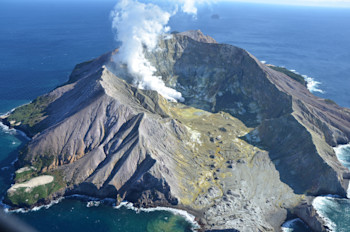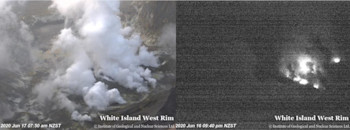
Some Frequently Asked Questions around the recent change in Volcanic Alert Level at Whakaari/White Island
Based on the slowly decreasing level of volcanic activity and unrest the Volcanic Alert Level for Whakaari/White Island was lowered to Level 1 on June 16. Here we address some of the frequently asked questions around this change.
Does the decrease in Alert Level mean it's safe to go to the island now?
There is always some risk in visiting an active volcano. The Volcano Alert Level (VAL) represents the current state of the volcano and this is now assessed as minor unrest – VAL1, a drop from moderate to heightened unrest – VAL2. The Volcano Alert Level is not a forecast of future activity. An eruption could still occur at VAL 1 with little no warning, as it did in April 2016 when the VAL for Whakaari/White Island was at Level 1.
All agencies and groups make their own decisions regarding safety and risk when visiting Whakaari/White Island, GNS does not make those decisions for them. GNS Science has its own internal process to make its own decisions about GNS staff visiting the island.
Can the public return to the island?
Agencies involved in the Whakaari/White Island Recovery Project are reminding the public that Whakaari/White Island is a privately-owned Island and remains off limits. The drop in Volcanic Alert Level is not a sign that it’s safe - or permitted - for anyone to return to the island.
Will GNS be going to Whakaari?
Our scientists and monitoring team do intend to return to Whakaari/White Island in due course. We have our own internal process for decision-making around GNS staff visiting the island. Any future visit to Whakaari/White Island will be closely coordinated with the other agencies and partners in the Whakaari/White Island Recovery Project
What's the volcano doing now?
As we detailed in the June 16 Volcano Alert Bulletin, volcanic unrest at Whakaari/White Island continues in line with it being one of New Zealand’s active volcanoes. Gas and vent temperatures, tremor and gas emissions have stabilised in recent months to a somewhat consistent level, but with occasional spikes in line with this still being a very active system. While Whakaari/White Island appears reasonably stable today, this volcano can still have life-threatening steam-driven eruptions at any time with little or no warning.
Why has the VAL dropped now? What's changed?
Recent monitoring of Whakaari/White Island by our scientists has shown that activity and monitored parameters have decreased to a level where it is currently considered as ‘minor volcanic unrest’. This has prompted us to lower the Alert Level.
The Volcanic Alert Level (VAL) is set by a vote across the experts in our GeoNet Volcano Monitoring Group. For volcanoes at VAL1 or higher they are voted on at weekly Group meetings, or in response to a notable change. The vote at this week’s meeting was to lower the alert level at Whakaari/White Island in line with the overall decrease in activity over time and further confirmation that the gas pulse observed in May was over.
What about the recent quakes?
Clusters of small earthquakes between Whakaari/White Island and the BOP Coast are relatively common. Many faults exist in the eastern Bay of Plenty and these extend offshore. The June 2020 events are 10-15 km from the island, rather than directly under the active volcano.
Moderate earthquakes related to the plate boundary processes at East Cape can also occur at depth in the Whakaari/White Island area. These are usually deeper than 30-40 km.
Will the Volcanic Alert Level stay down?
If there is a change in monitored unrest in the future at Whakaari/White Island, the VAL will be increased as the GeoNet Volcano Monitoring Group see appropriate.
An eruption could still occur at VAL1 or 2 with little or no warning. When an eruption occurs, we immediately raise the VAL to Level 3 or higher.
What about the investigation and future adventure tourism?
These are valid and important questions. The investigation and Coronial inquiry are ongoing and will deal with many issues. We cannot comment on matters that would prejudice those processes, and it is not GNS sciences role to comment on adventure tourism on the island.
Media Contact: 021 574 541 or media@gns.cri.nz




